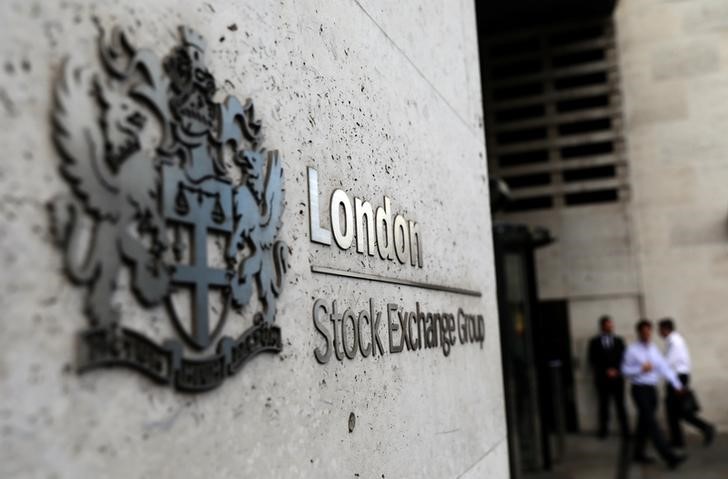By Marc Jones
LONDON (Reuters) - Signals the Federal Reserve will hike U.S. interest rates again this year and begin the 'Great Unwinding' of a decade of aggressive stimulus, drove the dollar to a two-month high versus the yen on Thursday and sent bonds and commodities lower.
Traders reacted predictably to what had been a heavily-flagged move from the Fed, which was then followed just as unsurprisingly in Asia as the Bank of Japan kept its monetary spigots open at full.
Along with the dollar bulls, European bank stocks (SX7P) cheered the prospect of higher interest rates which should help their profits. They rose over 1.5 percent as a weaker euro
Wall Street looked set for a subdued restart however, as shorter-term government bond yields, which reflect borrowing costs, hovered at their highest in nine years and the dollar's rise took it as far as 112.725 yen
"Initial reaction (to the Fed) is fairly straightforward," said Saxo Bank head of FX strategy John Hardy.
"They still kept the December hike (signal) in there and the market is being reluctantly tugged in the direction of having to price that in."
Interest rate futures are now pricing in about a 70 percent chance of a December Fed rate hike according to CME's 'FedWatch' tool, up from above 50 percent prior to the Fed meeting and under 40 percent just a few weeks ago.
There was one surprise for traders to deal with.
S&P Global became the second major rating agency this year to cut China's credit score, citing worries about the country's rising debt levels and the risks that posed for financial stability in the world's second largest economy.
China's markets were already closed by the time it came but it kept the pressure on metals and emerging markets stocks (MSCIEF) which were already down after the Fed meeting and as Russia was forced to bail out one of its large banks.
Since the start of 2014, Reuters analysis shows that the big three rating agencies - S&P Global, Moody's and Fitch - have racked up more than 155 emerging market downgrades between them, which averages out a roughly one a week.
The likes of S&P also still have far more negative outlooks -- effectively downgrade warnings -- on EM sovereign ratings than positive ones too, which suggest further cuts are looming.
"China's credit problem is the biggest problem we have ever seen in any country and probably justifies a lower rating," said Claire Dissaux, head of global economics and strategy at Millenium Global Investments.
"Also one element that models cannot capture is the strength of institutions such as transparency of regulation of the banking sector and central bank independence. All that is an argument to say China's rating might still be too good."
GREAT UNWINDING
The Fed's plan to start reducing its $4.2 trillion crisis-era stockpile of bonds and raise U.S. rates again was still the driver though as U.S. markets prepared to reopen.
The euro shed roughly 0.1 percent to $1.1890
European Central Bank President Mario Draghi is due to speak later on financial stability though focus will be on whether he give any more hints on the ECB joining the "Great Unwinding" as the influential Bank for International Settlement (BIS) has described it.
The yield on Germany's 10-year government, the benchmark for the region, was 4 basis points higher at 0.47 percent, its highest since early August. It is still well below the 2.28 percent U.S. equivalent though.
The gap between United States and German 10-year borrowing costs narrowed a touched to 179 bps having struck 184 bps - its highest in a month - on Wednesday.
Spanish government bonds moved roughly in line with peers, having underperformed on Wednesday after Spanish police raided Catalan government offices and arrested officials on Wednesday to halt a banned referendum on independence.
"The central Spanish government's increasingly rigorous line of action in response to Catalonia's aspirations to independence triggered profit-taking on Spanish debt instruments, which subsequently spilled over to BTPs (Italian debt)," DZ Bank analyst Rene Abrecht said.
COMMODITIES
The higher dollar strained commodity markets, where the underlying raw materials are priced in the U.S. currency.
Gold
Brent crude futures (LCOc1) last stood at $55.83, down around 1 percent from late U.S. levels as U.S. benchmark West Texas Intermediate (WTI) (CLc1) fell to $50.14.
There were other beneficiaries though from the shift up in the dollar.
Japan's Nikkei (N225) closed up 0.2 percent as the yen's fall against the dollar after the Fed's decision helped sentiment around exporters.
The Bank of Japan, as widely expected, also maintained its ultra-easy policy settings.

"The BOJ will patiently continue accommodative monetary policy to achieve 2 percent inflation... As such, we will take further monetary easing steps if necessary," its Governor Haruhiko Kuroda said at his post-meeting news conference.